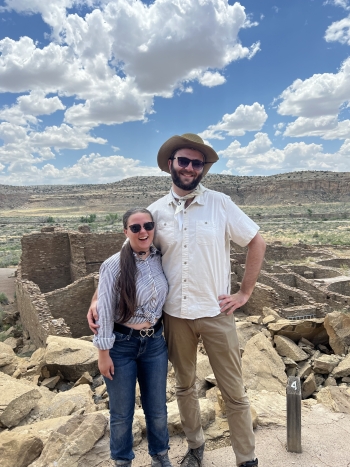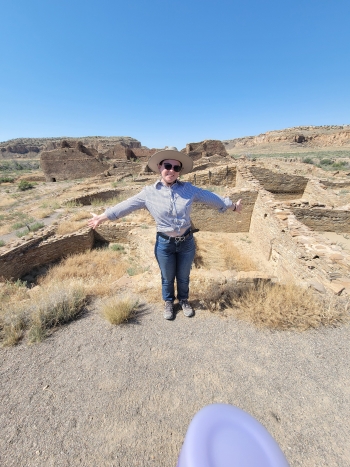Anthropology students get hands-on experience at summer field school

ASU Online student, Jonathan Hazel, looking for worked stone at the City of Rocks State Park, New Mexico.
Hands-on experience, learning about different cultures and engaging in nondestructive archaeological excavations – students at Arizona State University participate in summer field school.
Every year the nonprofit organization Archaeology Southwest in southern Arizona, selects students from across the United States to participate in archaeology field school. This year was the first year the organization ran a preservation field school, and Arizona State University students were the first cohort.
“Our curriculum highlights the goals, ethics, and practice of Preservation Archaeology, which integrates research, education, preservation, and engagement with Indigenous and local communities,” explained the Archaeology Southwest website.
This summer, two Arizona State University students were chosen to participate in the collaborative field school in Tucson, Arizona and Silver City, New Mexico. We talked with the students about their experiences as an ASU Online student and in-person student.
Editor's note: Answers have been edited lightly for length and clarity.
Jonathan Hazel was an ASU Online student who majored in history and anthropology and recently graduated.
Question: Are you an online student or an in-person student?
Answer: I’m an ASU Online student from Rhode Island and had never been to Arizona before this experience. I previously earned an associate's degree in a different field, but as a Starbucks College Achievement Program (SCAP) scholar, I was able to redirect my studies toward my true passion, the historical sciences, without seriously indebting myself. Attending this field school allowed me to finally visit the region I’ve been studying in for about three years now. It was an amazing experience and I’m excited to return for my graduation ceremony this winter!
Q: What did you learn about during this field school experience?
A: A significant portion of our time was devoted to the intricacies of museum curation. We worked on rehousing, analyzing and cataloging artifacts from the original NAN Ranch excavation of the 1970s through the 1990s into the Western New Mexico University Museum's virtual database. Many of the original artifact boxes hadn't been touched in decades, so transferring them to more stable housing and performing analyses was not only educational but also deeply fulfilling. It gave me a sense that our work would have a lasting positive impact on the field.
We also spent about seven days conducting archaeological surveys along the Mimbres River in New Mexico, where we walked transect lines to determine site boundaries, completed state archaeological forms, mapped sites using GPS equipment and documented petroglyphs.
The proximity to the Mimbres River allowed us to survey sites with both pre-contact and historical features, providing a very diverse experience. Since the field school focused on archaeological preservation, we conducted no excavations. Instead, we engaged with sites in non-intrusive ways, acting as stewards and temporary guardians of the archaeological record—a non-renewable resource that requires restraint to ensure future generations have the opportunity to explore the field.
Lastly, we had the opportunity to participate in experimental archaeology, creating period-accurate Basketmaker Culture objects such as atlatls, obsidian points, knives and shell art pendants.
Q: Were all the students who participated from Arizona?
A: Not at all, though I went into things expecting this to be the case. We had students from Massachusetts, Maine, Maryland, New Mexico, South Dakota, Illinois and a few others. I was pretty surprised to learn that not only did students from the Southwest comprise about half or less of the students - I wasn't even the only student from New England!
Q: Can you tell me about the research you presented at New Mexico’s Grant County Archaeological Fair?
A: My research focused on analyzing the evidence for and against varying degrees of contact between the Classic Mimbres Culture and Mesoamerica.
I approached this study with an open mind, given the strong opinions on both sides of the debate. However, it was also critical to proceed cautiously, as the American Southwest has a long history of its archaeological features being attributed to nearly every group except the descendant communities.
This includes theories ranging from the American Southwest as the mythical origin of the Aztec homeland, Aztlán, to more fringe ideas involving ancient Israelites and Egyptians and extraterrestrial beings.
To ground my analysis, I selected five case studies that represent the most compelling arguments and provide a framework for understanding how archaeologists approach such topics:
- The presence of scarlet macaw remains in Classic Mimbres sites
- Alleged depictions of the Hero Twins from the Maya Popol Vuh on Classic Mimbres pottery
- The presence of copper bells in Classic Mimbres sites
- A comparison of infrastructure and organization between Classic Mimbres settlements and Mesoamerican cities
- A comparison of social stratification in Classic Mimbres and Mesoamerican societies, including Pochteca theories
My conclusion was that, while there are some striking similarities between the Mimbres and Mesoamerican societies that seemed to intensify during the Classic Mimbres period, the archaeological record lacks compelling evidence for direct contact with Mesoamerican sites. Instead, these similarities are more likely attributable to broad regional parallels and mercantile interactions with intermediary cultures in Northern Central Mexico.
Q: How did this experience help you as an ASU student?
A: This experience truly tested my mettle. ASU has provided me with a diverse and balanced education in history and anthropology, and I’ve been more than satisfied with it.
While my ability to succeed while not even physically present on my college's campus certainly speaks for itself - I sometimes wondered if being on campus in Tempe would have been "better."
Attending an archaeological field school, which was physically and mentally demanding, was great for my sense of accomplishment and proved that ASU Online students can perform just as well as on-campus students from any university.
It was also incredible to meet Lydia, someone I had never met before, and immediately bond over professors and classes we had both taken, and even some events she was at that I had attended virtually. For me, this reinforces why ASU is consistently ranked #1 in innovation.
Lydia-Ann Snyder is an in-person student at Arizona State University majoring in anthropology and double minoring in Art History and Women, Gender, and Sexuality Studies.
Q: Can you tell us about yourself and your career at ASU?
A: I’m in my 3rd year as an anthropology major and I’m also double minoring in Art History and Women, Gender, and Sexuality Studies. I’m also part of Barrett the Honors College. I’ve been an in-person student for my entire time at ASU.
I heard about Archeology Southwest’s field school after I started looking into available field schools online, following the advice Wondra Lee, an advisor at the School of Human Evolution and Social Change and Barrett faculty member Laura Jacubczak. Teaching professor Jacubczak also was generous enough to write my letter of recommendation for the application.
I was already familiar with Archeology Southwest because I live in Tucson, where they are based out of, but I didn’t know they offered a field school. This program stood out to me because it offered a wide variety of activities such as experimental archeology, survey, museum studies and trips to various archeological sites and museums.
Although field schools can be quite pricey, Archeology Southwest was given a large grant this year so the cost was significantly reduced. I did pay the tuition to Western New Mexico University so that I could get the credits and transfer them to ASU. The program offers you seven credit hours from either the University of Arizona or Western New Mexico University, both of which Archeology Southwest collaborates with.
Another one of the appeals of this field school was that I wouldn’t have to travel by plane. One other student was also from Tucson, and one was currently working with the Kaibab National Forest in northern Arizona as a professional archeologist. However, most of the other students weren’t from Arizona.
Students from all over the country traveled to participate in the program.It was a really cool opportunity to meet people who shared my passion for archeology that I wouldn’t have met otherwise. The field school culminated with students presenting small research projects at the Grant County Archeology Fair. I focused on combining historical records with archeology to make a more complete picture of personal identity.
I used one of the homesteads we surveyed as a case study. I learned so much at this field school that I never could learn in traditional lectures, or even in a Research Apprenticeship Program. I think it’s going to be much easier to critically understand the things I learn in the classroom now because I’m going to have a real-world scenario that I can think back to.
Becoming an archeologist has been my dream since middle school and it feels amazing to accomplish my goals. It has prepared me for the workforce and has given me the confidence to look for graduate programs and continue a lifelong pursuit of archaeology. The field school has also enabled me to become fully qualified for a Cultural Resource Management position, even before I graduate with my Bachelor's, so maybe that’s on the agenda for next summer.



